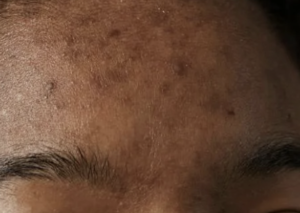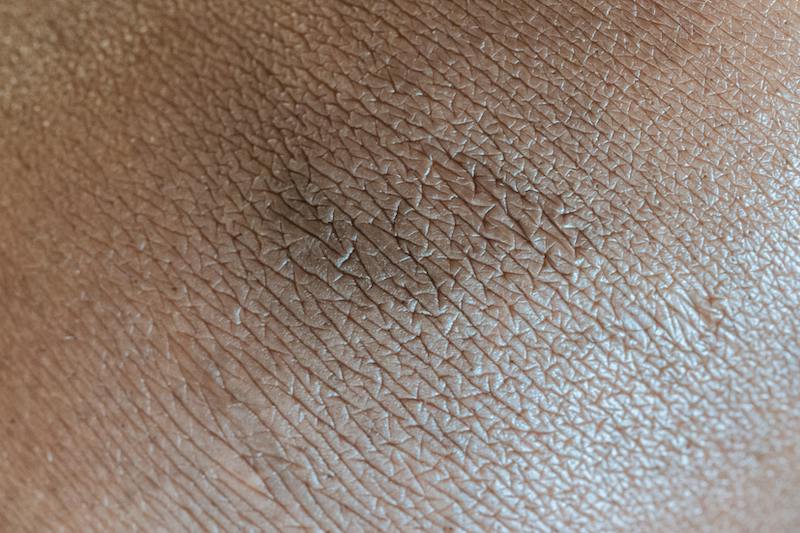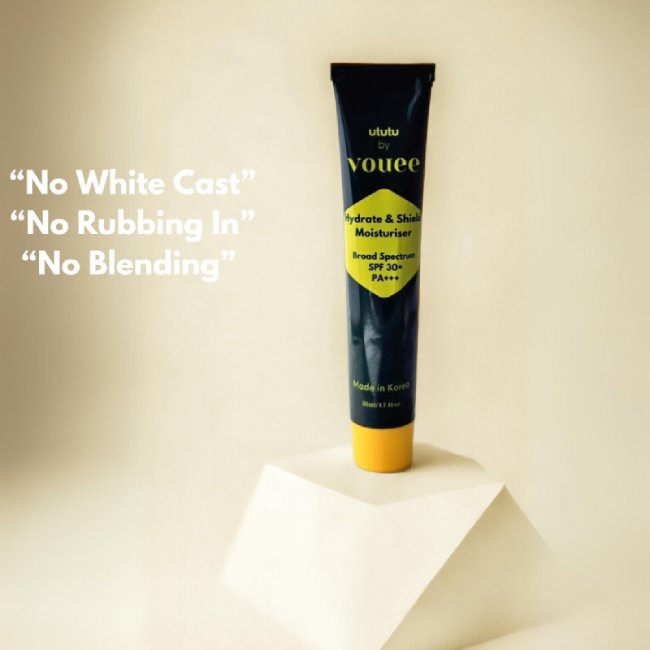The information presented on this website is not intended as specific medical advice and it is not a substitute for professional treatment or diagnosis. These statement have not been evaluated by the FDA. This product is not intended to diagnose, treat, cure or prevent any diseases.
The Ultimate Routine for Dark Spots | Your Guide to Hyperpigmentation and Melasma

Dark spots and hyperpigmentation are some of the most common concerns in skincare—especially for those with melanin-rich skin.
Whether it’s melasma, post-inflammatory hyperpigmentation (PIH), or sun-induced dark spots, tackling uneven skin tone can be a challenge without the right approach.
This guide is designed to give you everything you need to know about preventing and treating dark spots, including:
- What causes dark spots
- How to build the ultimate routine
- The most effective treatments for hyperpigmentation
We’ll walk you through step-by-step solutions—all grounded in science and powered by ingredients that work at every level of the pigmentation process.
Key Takeaways for Treating Dark Spots
✔ Sunscreen is non-negotiable – Use SPF 30+ daily to prevent further darkening.
✔ Use brightening actives wisely – Ingredients like vitamin C, niacinamide, and retinoids help fade discoloration over time.
✔ Avoid harsh exfoliation and irritation – Mild chemical exfoliation and hydration are key to avoiding inflammation.
✔ Consistency is everything – Hyperpigmentation takes weeks to months to fade, so patience is essential.
What Are Dark Spots and How Do They Form?

Dark spots are flat, discolored areas on the skin caused by excess melanin production.
The most common types include:
- Melasma – Often triggered by hormones, melasma appears as patchy areas of pigmentation, usually on the face.
- Post-Inflammatory Hyperpigmentation (PIH) – These dark marks form after skin inflammation, like acne or irritation.
- Solar Lentigos (Sunspots) – Also known as age spots, these result from prolonged sun exposure over time.
What Causes Dark Spots?
Three main factors contribute to dark spots:
- Sun Exposure – UV rays activate melanocytes, the pigment-producing cells in your skin, leading to dark spots.
- Hormonal Changes – Conditions like pregnancy or the use of birth control can trigger melasma.
- Inflammation – Acne, cuts, and skin irritation can leave lasting pigmentation in melanin-rich skin.
The Hyperpigmentation Treatment Pyramid
When it comes to treating dark spots, think of your routine as a pyramid. Each step builds on the last, with sunscreen as the foundation.
Without a strong foundation, everything else you use—no matter how powerful—won’t deliver the results you want.
Here’s how to structure your hyperpigmentation routine for maximum effectiveness.
Step 1: The Foundation – Sunscreen (SPF 30+ and Tinted Options)
Why It Matters: Sunscreen is non-negotiable. UV rays worsen hyperpigmentation and trigger melanin production, making existing dark spots darker.
For those with melanin-rich skin, tinted sunscreen is especially beneficial because it blocks both UV rays and visible light, which can contribute to pigmentation issues.
Product Suggestion: Use a broad-spectrum sunscreen with SPF 30+ that’s hydrating and blends easily into deeper skin tones.

Step 2: Topical Treatments (Day and Night)
Once you’ve built the foundation with sunscreen, it’s time to target dark spots at the molecular level.
Remember, dark spots form through three key processes:
- Pigment production
- Pigment transfer to skin cells
- Deposition and retention of pigment
Your goal is to use treatments that address each step to ensure long-lasting results.
Morning Routine (Prevention & Protection)
- Vitamin C: A powerful antioxidant that brightens the skin and reduces oxidative stress.
- Niacinamide: Reduces inflammation, strengthens the skin barrier, and helps fade discoloration.
- Licorice Root Extract: Helps inhibit melanin production and calms irritated skin.
Night Routine (Repair & Targeted Treatment)
Evening is when the real work begins. Nighttime treatments help boost cell turnover and fade existing pigmentation.
- Retinoids (Encapsulated Retinol or Tretinoin): These promote cell turnover, reduce the appearance of dark spots, and smooth skin texture.
- Alpha Hydroxy Acids (AHAs): Gently exfoliate to remove dead skin cells and reveal fresher, more even skin underneath.
- Tranexamic Acid: This is not an ingredient we recommend at VOUEE as we feel it indiscriminately lightens. We have included it for completeness. It is known to reduce melasma and persistent dark spots by blocking pathways that trigger pigmentation.
Product Strategy: Pair a retinol serum with a gentle exfoliating product like mandelic acid once a week for a balanced routine that avoids irritation.
Step 3: Professional Treatments (Optional Add-Ons)
For stubborn pigmentation that doesn’t respond to over-the-counter products, in-office treatments can take your results to the next level.
These include:
- Chemical Peels: Use acids like glycolic or salicylic to resurface the skin.
- Microneedling: Boosts collagen production while improving skin tone and texture.
- Laser Therapy: Advanced options like Nd:YAG lasers are safe for melanin-rich skin.

Why This Pyramid Works
Each layer of the pyramid builds on the previous one, creating a comprehensive approach to treating hyperpigmentation.
Combining daily sunscreen, effective at-home treatments, and occasional professional procedures ensures your skin stays protected and clear.
The Ultimate Routine – Day and Night Skincare Steps
Building a skincare routine for dark spots doesn’t have to be complicated. The key is to focus on consistency, layering the right products, and tailoring your routine to your skin’s unique needs.
Below is a day-and-night guide to help you address hyperpigmentation effectively.
Morning Routine (Prevention and Protection)
Step 1: Gentle Cleanser
Start with a mild cleanser that removes overnight buildup without stripping your skin’s natural moisture.
Avoid harsh cleansers with sulfates, which can cause irritation and worsen hyperpigmentation.
Step 2: Antioxidant Serum (Vitamin C or Niacinamide)
Antioxidants help protect your skin from environmental damage and reduce melanin production.
Vitamin C brightens skin, while niacinamide soothes and strengthens the skin barrier.

Step 3: Moisturizer
Hydration is essential for maintaining a healthy skin barrier.
Use a lightweight, non-comedogenic moisturizer to lock in moisture and prepare your skin for sunscreen.
Step 4: Sunscreen (SPF 30+)
Sunscreen is the most crucial step in your morning routine. A tinted sunscreen is ideal for melanin-rich skin to block both UV and visible light.

Evening Routine (Repair and Targeted Treatment)
Step 1: Cleanse Again
Remove makeup, sunscreen, and daily buildup with a gentle cleanser.
Double cleansing (using an oil-based cleanser followed by a water-based one) is especially effective if you wear makeup.
Step 2: Retinoid Treatment
Retinoids are a gold standard for promoting cell turnover and fading dark spots.
Start with a low concentration and work your way up to avoid irritation.

Step 3: Moisturizer
End your routine with a soothing moisturizer to lock in all the treatments and help your skin recover overnight.
If your skin feels extra dry, add a few drops of a non-comedogenic oil like rosehip or squalane.
Weekly Add-On: Exfoliation (Once or Twice a Week)
Exfoliation helps remove dead skin cells and speeds up cell turnover, revealing brighter, more even-toned skin.
Choose a gentle exfoliant like mandelic or lactic acid to avoid irritation. If you are using the VOUEE Foam & Glow cleanser – it has both.
Why This Routine Works
This routine targets dark spots at every step—preventing new ones, fading existing ones, and maintaining a healthy, radiant complexion.
With consistent use, you’ll notice a more even tone and healthier skin.
Common Mistakes to Avoid
Even with the right products, certain habits can slow your progress or worsen hyperpigmentation.
Avoid these common mistakes to ensure you’re getting the best results from your skincare routine.
1. Skipping Sunscreen
The Mistake: Many people with melanin-rich skin believe they don’t need sunscreen due to natural UV protection.
However, skipping sunscreen allows dark spots to darken further and makes other treatments less effective.
The Fix:
- Apply a broad-spectrum SPF 30+ sunscreen daily.
- Reapply every 2 hours if exposed to the sun.
- Opt for tinted sunscreen to block visible light, which also contributes to hyperpigmentation.
2. Over-Exfoliating or Using Harsh Scrubs
The Mistake: Exfoliation is great for fading dark spots, but overdoing it can irritate the skin, trigger inflammation, and lead to more hyperpigmentation.
The Fix:
- Use a gentle chemical exfoliant (like mandelic or lactic acid) only 1–2 times per week.
- Avoid scrubs with large particles, as they can cause microtears in the skin.
- Never combine strong exfoliants and retinoids in the same routine.

3. Using Too Many Actives at Once
The Mistake: Layering too many powerful ingredients (e.g., vitamin C, retinol, AHAs, BHAs, and hydroquinone) can lead to irritation, dryness, and worsen pigmentation.
The Fix:
- Stick to one active ingredient for each step (e.g., vitamin C in the morning, retinol at night).
- If using multiple treatments, alternate days rather than applying them all at once.

4. Picking at Your Skin
The Mistake: Squeezing pimples or scratching at dark spots can cause more inflammation and worsen post-inflammatory hyperpigmentation (PIH).
The Fix:
- Treat breakouts with spot treatments instead of picking.
- Use calming ingredients like niacinamide to reduce redness and irritation.
5. Not Being Consistent
The Mistake: Expecting overnight results and frequently switching products can slow progress. Hyperpigmentation takes time to fade, and patience is key.
The Fix:
- Stick with your routine for at least 8–12 weeks before expecting visible results.
- Take progress photos to track improvement over time.
Why Avoiding These Mistakes Matters
By steering clear of these common errors, you’ll maximize the effectiveness of your skincare routine and see faster, longer-lasting results.
Conclusion and Final Thoughts
Hyperpigmentation and dark spots are stubborn but not impossible to treat—especially when you take a consistent, multi-step approach. The key is prevention, targeted treatment, and patience.
By following this science-backed routine, you can gradually fade existing dark spots, prevent new ones from forming, and achieve a more even skin tone.
Ready to Start Your Dark Spot Routine?
Browse our hyperpigmentation solutions and build a routine tailored to your skin’s unique needs.
